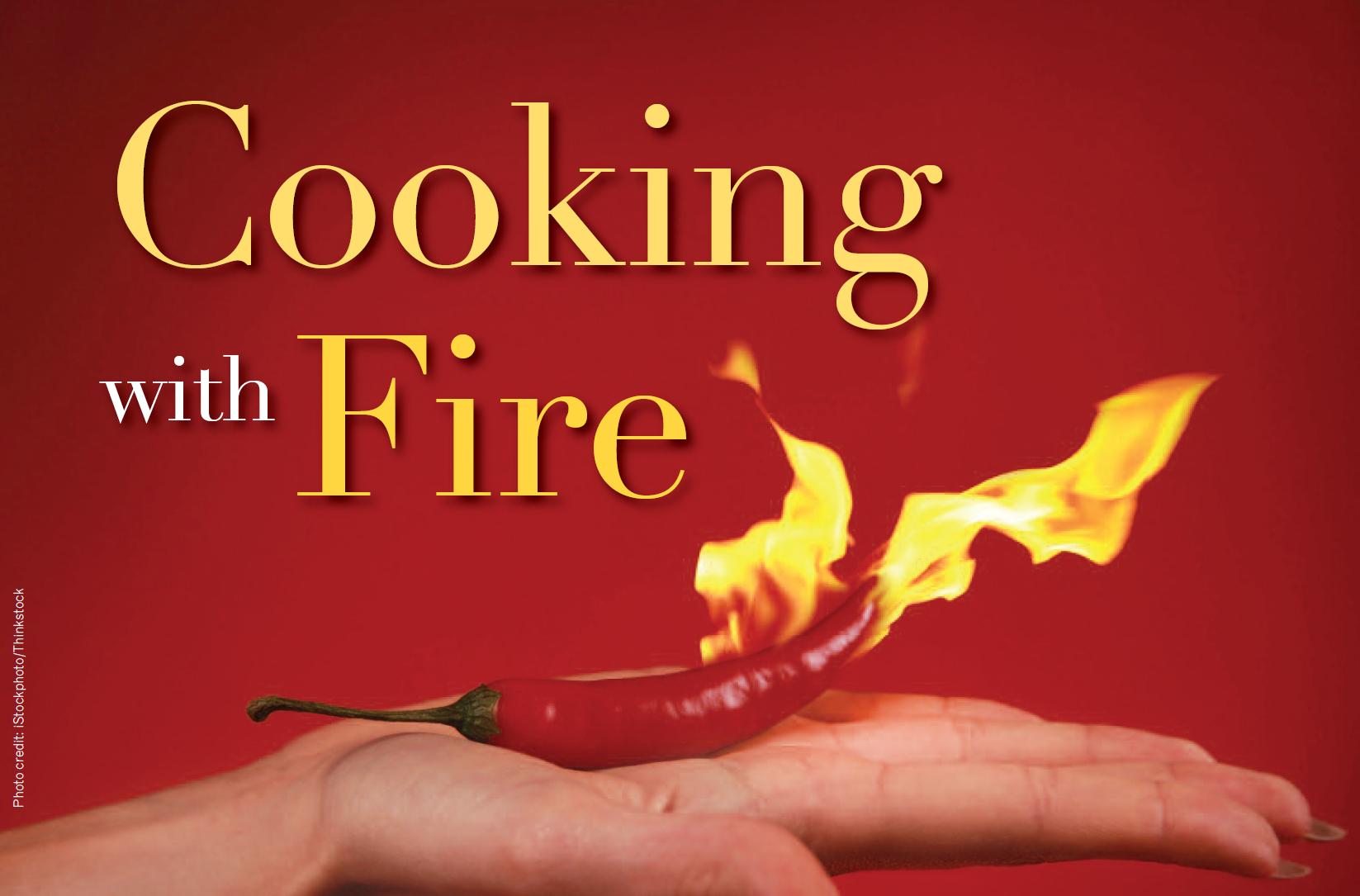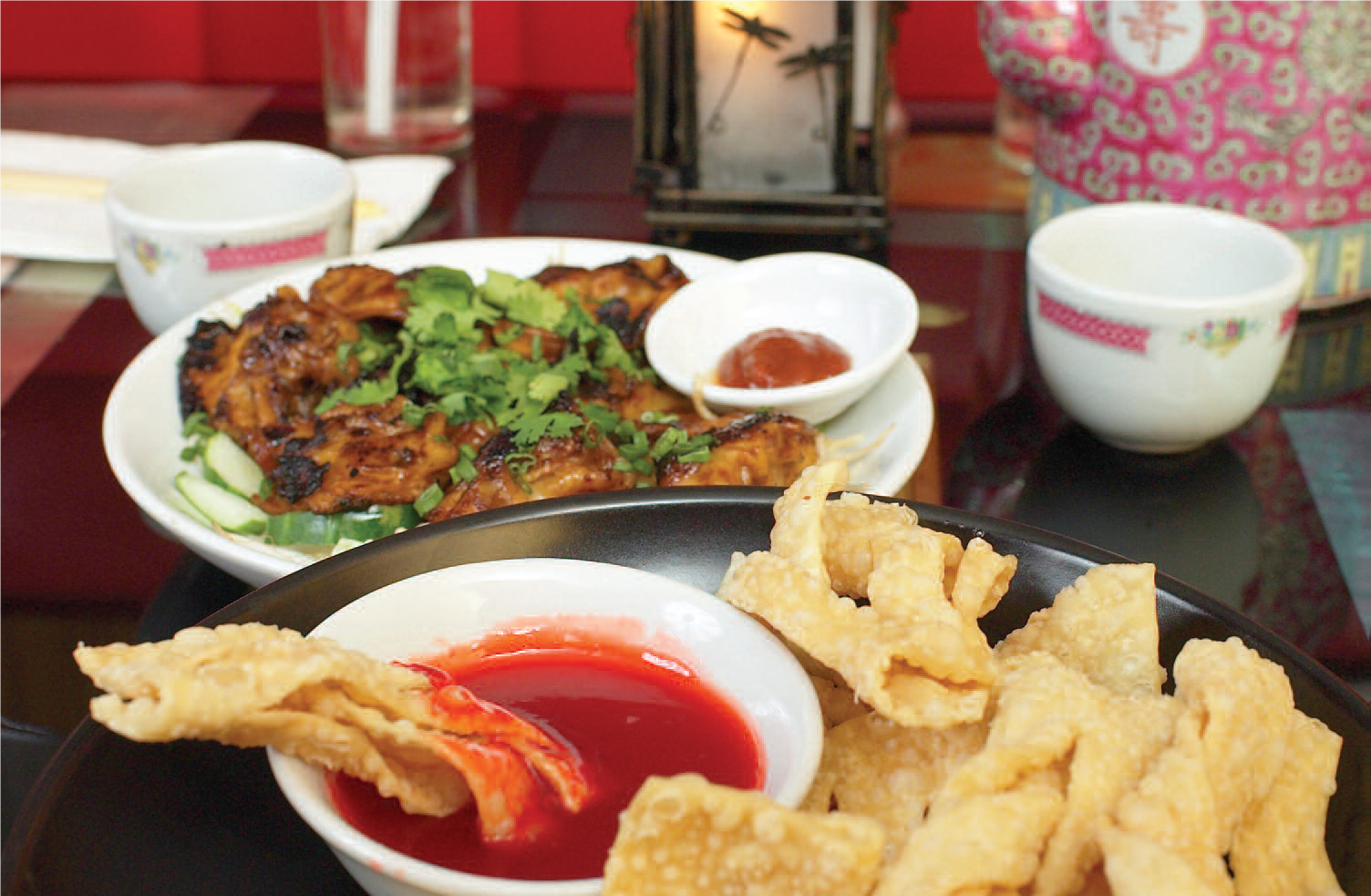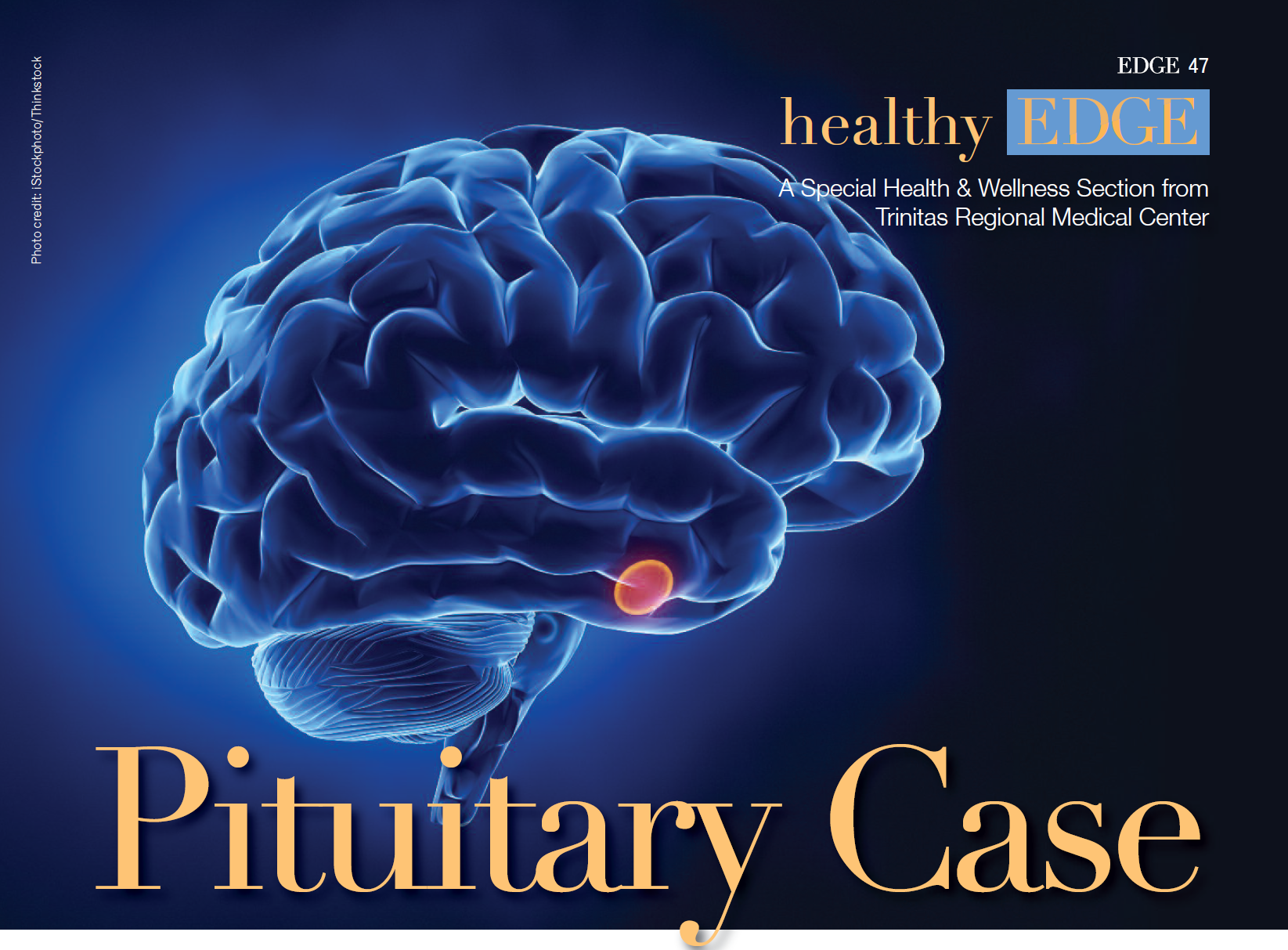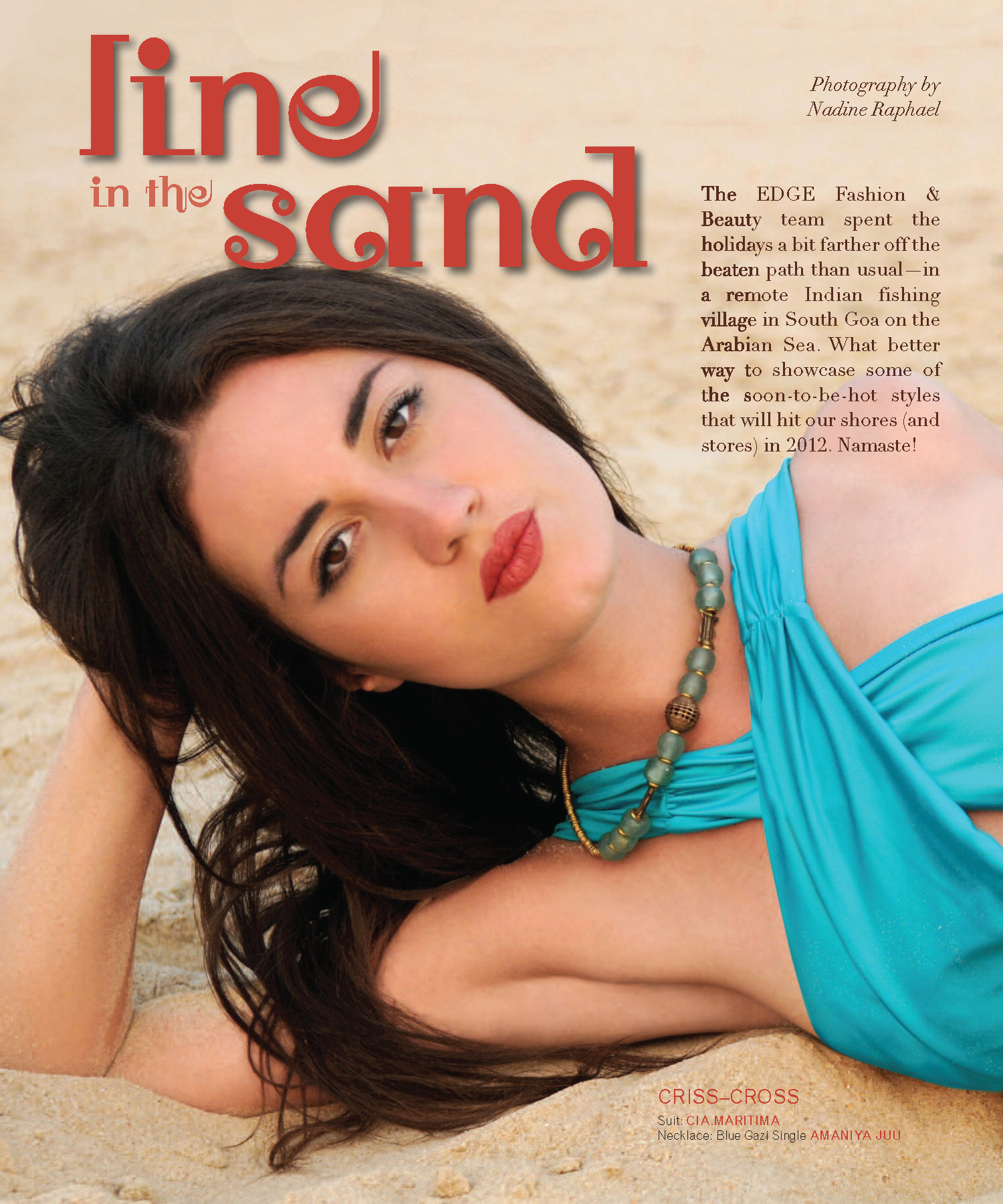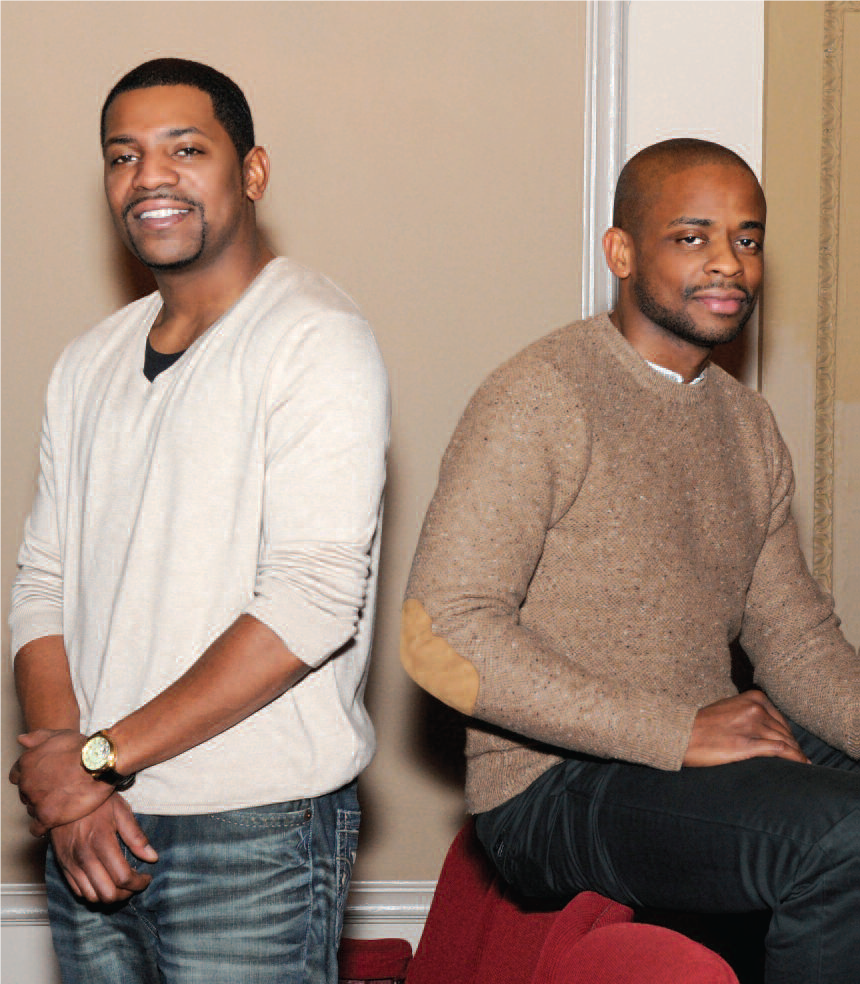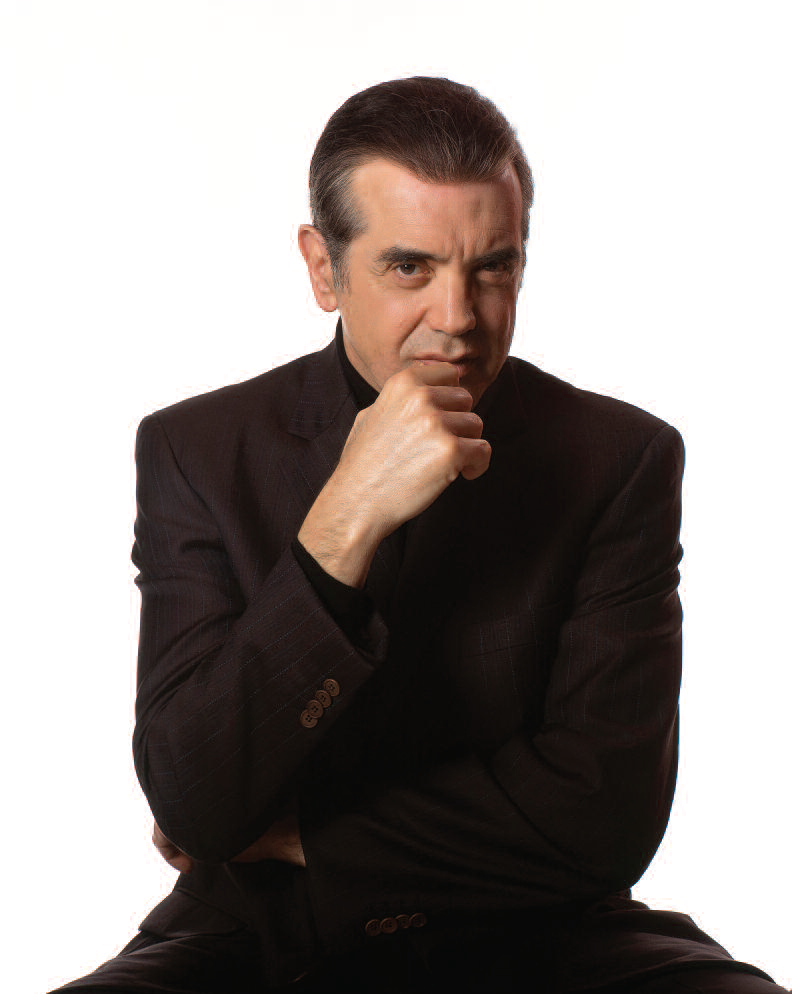How I learned to love the Habañero
When I was a sous-chef at the River Café in New York in the early 1980s, there was a creative punishment awaiting kitchen staff that showed up late for work. The  chef would slice off the top of a bell pepper and thread a string through it like a party hat. You would have to wear that hat throughout your shift, and endure taunts of “pepper-head” until it was time to go home. You knew there was bad traffic coming into the city if three or four guys were wearing pepper hats. Three decades later a couple of things have changed in the food business. First, that would probably be considered workplace harassment today. Second, and more important, the use of peppers in the kitchen has definitely evolved. I use a variety of peppers on every menu in every one of my restaurants, and I try to be as imaginative and creative with my choices as I can. Some I use for seasoning, some for flavor, some for heat.
chef would slice off the top of a bell pepper and thread a string through it like a party hat. You would have to wear that hat throughout your shift, and endure taunts of “pepper-head” until it was time to go home. You knew there was bad traffic coming into the city if three or four guys were wearing pepper hats. Three decades later a couple of things have changed in the food business. First, that would probably be considered workplace harassment today. Second, and more important, the use of peppers in the kitchen has definitely evolved. I use a variety of peppers on every menu in every one of my restaurants, and I try to be as imaginative and creative with my choices as I can. Some I use for seasoning, some for flavor, some for heat.
And although I am far from an expert on peppers, I can’t imagine cooking without them. That’s a far cry from my early days in the business. Thirty years ago, Southeast Asian cooking was practically unknown and chefs like Dean Fearing, Mark Miller and Bobby Flay were just starting to bring Southwestern cuisine into the mainstream. I had worked in French restaurants my whole life, so when it came to peppers I was a complete neophyte. I’ll never forget my introduction. One day at the River Café, someone tricked me into chomping into a scotch bonnet. I almost jumped in the river. I didn’t know what to do. I couldn’t get rid of the heat. It was a hot day to begin with and I really thought I was going to keel over. I was pissed! For years after that, I couldn’t eat Thai food. I remember once at a friend’s restaurant in Chicago, he served me a dish that was so hot that I got really mad at him. It ruined the whole meal. I couldn’t taste the wine we ordered. He pointed out that I’d bitten into a chili that was there for color and flavoring. It wasn’t meant to be eaten.
Later, when I first started working with different types of peppers, I still didn’t fully understand or respect their power.

Photo credit: iStockphoto/Thinkstock
One time, we were working with a particularly potent pepper. I was sweating a lot that day and I inadvertently used the same hand that was handling the pepper to wipe my brow. Well, about 20 minutes later it felt like someone had stuck a screwdriver in my eye. Again, I was very new to working with peppers, so I didn’t realize what I’d done. Overnight, it spread across my nose into my other eye. I couldn’t see! I ended up going to the hospital thinking I had some disease that was making me go blind. The doctor asked me what I’d been doing and worked out what the problem was. The next day I had a business meeting with Phil Suarez, who is Jean Georges’s partner. It looked like someone had worked me over with a baseball bat—both of my eyes were purple-red. He still gives me a hard time about that when I see him.
Even today, I make a pastramied salmon that involves boiling molasses with cayenne pepper. We paint the mixture on the fish, and then smoke it. Your hands get sticky with the molasses and it can work its way into your skin and under your fingernails. If you go to bed—or, worse, to the bathroom—without completely scrubbing off the cayenne mix, you’ll be in bad shape, believe me. And during my days working in Hong Kong, I learned another important lesson: never eat Chinese food in the dark. The peppers used in cooking belong to the Capsicum family. They include a lot of familiar names, like jalapeño, cayenne, chipotle, poblano, habañero, scotch bonnet, serrano and, of course, bell peppers of various colors. Most sources credit Christopher Columbus with giving peppers their name. He brought them back from the New World and named them after black pepper, which was the only hot spice Europeans were using at the time. Black pepper was incredibly expensive in the 1400s—in some places it was used instead of money—so the “discovery” of a new way to spice up food was big news. Spanish and Portuguese explorers and traders spread peppers to Africa, India, and Asia. Paprika got to Hungary through  Asia, not through Europe, which is interesting. Not for nothing, but paprika is one of the trickier peppers to cook with. You really have to open it up and let it bloom.
Asia, not through Europe, which is interesting. Not for nothing, but paprika is one of the trickier peppers to cook with. You really have to open it up and let it bloom.
Today I am a big proponent of peppers. Cayenne is my friend. I always have serranos and jalapeños on hand. We use serrano peppers in our firecracker applesauce. It’s great how the heat and sweet mixes together. First you get the sweet, and then the heat kicks in. I didn’t like jalapeños at first, but now I think they are a great way to get exactly the amount of heat you want in a dish. I am a huge fan of the peppadew, a sweet, piquant pepper that’s grown in South Africa. We put them on sandwiches and in salads. We make wonderful use of chipotles in our ranch dressing and our aioli. It’s extraordinary on our tuna tartare tacos. Of course, with all of the different pepper options out there, people tend to look down upon the old reliable bell pepper. For my money, it gives you the greatest depth of flavor. And that flavor experience changes depending on how you cook it. I think that among the bells, the green pepper gets overlooked. It has a little bitterness and a more unique flavor than red or yellow. Still, to bring out some heat and wake up the palate, it’s fun to work with the hot stuff.
I like a little bit of heat now and then, I have to admit. If you’re feeling adventurous, I recommend experimenting with habañeros. Make a habañero butter and put in on a steak or a pork chop or a burger. Keep some in the fridge and on weekend mornings spread it on some toast with eggs. Think of it as the gateway pepper—you can go up or down the Scoville scale from there according to taste. Some final thoughts on peppers. When you bite into a hot pepper, no matter how convinced you are that you’ve singed the taste buds off your tongue, that’s not what’s happening. It may be uncomfortable, but you’ll survive. Peppers activate the pain receptors on your tongue and in your throat, so it sends a pretty strong message to your brain at first. In football, the first time you get tackled you feel like you’ve been in a car wreck. But you get used to the pain and even get to like it a little. For most people, the same is true when it comes to cooking with peppers. As long as you remember to wash up before rubbing your eyes (or visiting the restroom), the discomfort will be contained to a place where you are also experiencing some incredible flavors and textures. It’s a trade-off I’d make any day. Besides, who doesn’t like a little pain with their pleasure from time to time?
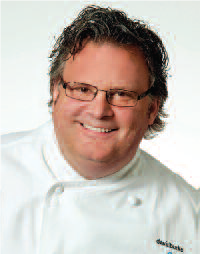 Editor’s Note: David Burke owns Fromagerie in Rumson, Primehouse in Chicago, Prime in Connecticut, and Fishtail, David Burke Townhouse, and David Burke Kitchen it the James Hotel in Manhattan.
Editor’s Note: David Burke owns Fromagerie in Rumson, Primehouse in Chicago, Prime in Connecticut, and Fishtail, David Burke Townhouse, and David Burke Kitchen it the James Hotel in Manhattan.
Plates here arrive awash in subtlety, with sauces demure and focused, main elements expertly cooked, technically precise.

Photo credit: iStockphoto/Thinkstock
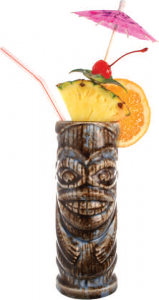
Photo credit: iStockphoto/Thinkstock
“Sam,” I say to my friend who is about to leave with his family on a trip abroad, “once upon a time in New Jersey, there wasn’t sushi on every corner or places nearby where you get tacos or tortas or other Mexican foods. There weren’t Thai restaurants. You know that, right?” Sam is 11 and, after hearing my spiel, puzzled. “Really, Andy?” he asks. “No California rolls?” I don’t want him to think I grew up deprived. But, compared to the variety of restaurant options we have today, the New Jersey I grew up in circa the 1960s and 1970s was, at best, limited. “When I was your age,” I tell Sam as we navigate the Garden State Parkway, “there was pizza and Chinese and that was about it for ethnic food.” I quickly realize I need to qualify Chinese. “I’m not talking Szechuan or soup dumplings or any of the things we eat now. Chinese was…well, Chinese was very different back then.” Which is why we are en route to Lun Wah, a classic in Roselle since 1974.
I wanted Sam to come back in time with me to a vintage New Jersey-style Cantonese/Polynesian restaurant, complete with tiki bar, waiters in Hawaiian-print shirts and a koi pond—a setting, a scene and a bill of fare almost extinct now in these parts. He’ll experience the most exotic foods of a generation past and realize what a treat it will be to have a chance to trek across the Atlantic to try a whole other new world of food. “Sam,” I continue as Steve Tyrell belts out Ain’t Misbehavin’ on my CD player, “you need to know how to take chances with new foods. You need to know how to order in a restaurant without falling back on the same-old, same-old stuff. You need to know this, Sam. You understand?” His response is barely audible, even though I’ve tamped down Tyrell. “Yeah,” he says. “When are we getting there?” We do get there, and settle into a bamboo-lined booth in one of two “palm”-tree lined dining spaces. Sam looks up at the fierce mask glaring down at us from its perch on the wall, then at me, unfazed. “How about Voodoo Steak?” I ask, and Sam laughs at the name. However, he’s appalled when I tell him we’re going to start with a pu-pu platter.” “Poo-poo? Oh, Andy, no!” Sam protests, until the platter arrives with a lazy-Susan arrangement of nibs and bits and a flaming mini-grill in the center.
Suddenly, Sam’s eyes glow. By the time we polish off our chunks of marinated beef, meaty hunks of ribs, shrimp toasts, packets of moist, spiced chicken and old-fashioned, pork-stuffed egg rolls, Sam is a big believer in the charms of Lun Wah’s superior pu-pu platter. Lun Wah is, after all, pure retro. As we spear cubes of beef, warming them for a minute on our grill, we see many diners file in. They’re all greeted by a veteran floor crew which seamlessly takes orders, delivers dishes and replenishes drinks served in pineapple shells trimmed with paper umbrellas and rimmed with plastic monkeys threatening to dive into the fruited spirits. By the time we’re served our resolutely Cantonese soups—a house wonton plumped not only with the steamed dough pouches filled with minced pork but also slices of chicken and roast pork, shrimp and crisp choy, and a thoroughly comforting chicken-corn that earned its moniker “velvet”—Sam’s ready to surrender to Lun Wah’s ways. “You can take the rest of the soup home,” I tell Sam, who is having a hard time saying goodbye to the kernels of corn and shreds of chicken swarming the not-too-thick soup base. This is a naturally thickened slow-cooked model, I suspect, for there is none of that cornstarch aftertaste that’s kept me from ordering the standard in many moons. Sam’s about to offer what I’m sure would’ve been a compelling argument for finishing every last drop of soup when our new best friend, Kenny—server sublime and master of Lun Wah ceremonies—arrives to see how we’re doing.
I take this as a cue our entrées are almost ready and, in turn, cue Sam to put down his spoon and prepare for more. “This place is the best, Andy,” Sam says, emphasizing the superlative with a slam-dunk imitation of one who has ingested a couple of Lun Wah’s Coco Locos, a concoction of rum and coconut milk. “What’s Volcano Steak?” Soon, he’s caught up on how he’ll describe to his family the multiple slabs of filet mignon set upon a thick layer of Chinese vegetables, all of which ring a tiny flame nestled in a citrus shell. Lun Wah doesn’t miss a chance to light a fire under, or for, its diners. But although there’s no shortage of ceremony and pomp, plates here arrive awash in subtlety, with sauces demure and focused, main elements expertly cooked, technically precise. The claypot subgum, a stew of myriad ingredients, illustrates that perfectly. There are chicken and shrimp, not a smidgen overcooked, shredded beef, muchos mushrooms and snow peas, broccoli and shards of more esoteric Asian vegetables in the heated pot. It’s bound by a light, sprightly sauce.
taste everything, individually. Nothing’s muddied. Grand Marnier shrimp, that luscious standard that at one time titillated, is textbook correct, with crunchy fried walnuts helping to offset the richness of the creamy, fruity sauce. Sam isn’t a shrimp fan (he’ll learn, he’ll learn), but he can’t get enough of that lush sauce, which he considers a kind of salad dressing for the thick slabs of cabbage and choy bedding the shrimp. We end as I always ended as a late-stage teen dining out with friends: with chocolate ice cream and chunks of pineapple.
On the way home, Sam, Lun-Wah-fortified, belts out his own personal rendition of “They All Laughed” and I don’t feel the need to reprise my beloved Steve Tyrell. But I do feel the need to reprise, for your sake, Lun Wah. So I return to check out several more classics that you might need to know about should you visit. Do you remember Happy Family? I remember Happy Family, and Lun Wah’s is a delirious version—the same that taught us about oyster sauce and how it relates to pork, shrimp, beef and chicken. Som Bo Duck is delicate and soothing, a splay of boneless duck breast amid chicken and shrimp, all atop a bevy of Asian vegetables. Coconut Shrimp never has been done as well in fusionfriendly New Age restaurants as it is here, with Lun Wah’s kitchen striking just the right balance of flakes to shellfish.
Just because we figured we should, we tried one of the handful of Szechuan selections, gingered beef that we asked to have kicked up to the max with hot sauce. The verdict? Gummy and one-dimensionally hot; no nuance, no finesse. Stick with Lun Wah’s core Cantonese/Polynesian dishes. Rather than doing dessert, use up your guilty-pleasure calorie allotment by starting your evening with one of the house-special drinks the folks gathering at the tiki bar so adore. Hawaiian Sunrise is a tart-tangy mix of lime juice and vodka. The Scorpion blends both light and dark rums with brandy, fruits and almond. Gin, lime juice and a liqueur (or two) we couldn’t divine and our server wouldn’t divulge make up the Bamboo Cooler. Lun Wah makes up in its warm wrap of nostalgia what it lacks in chic. There’s nothing new here. And there shouldn’t be. But when the call of the exotica of yore beckons, you’ll be glad to know it’s there, waiting for and welcoming baby boomers…and those whose generation has yet to be defined.
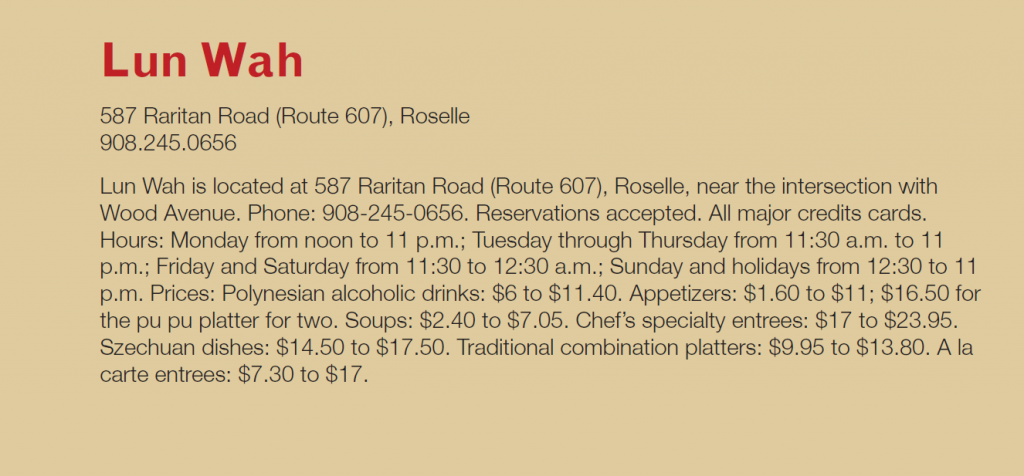
Hot Time in the Old Town
Horns honked and car traffic surged on all four sides of Tiananmen Square. Thirty years had passed since I last set foot on these ancient stones. Back in 1981, there were 35,000 cars in Beijing. Now there are five million. Where were the waves of bicycles, the main form of transportation of Mao and Deng Hsiao-ping’s eras?
It was mid-week, mid-morning in the third-largest city square in the world—in the capital city of the most populous country on the planet. My return trip was just a few hours old and already a lifetime of change was noticeable.

Scores of Asian tourists mingled, snapped photos and followed their leader’s flag or umbrella. Each group was differentiated by color-coded beanies of red, pink, orange, blue and even Burberry-like plaid. There were no green beanies in sight—to wear a green hat symbolizes a cuckolded husband. I imagined the bird’s-eye view of the square might look like a giant’s game of Chinese checkers.
The general appearance of the tourists spoke volumes about the changes Beijing has undergone. Head-wear uniformity notwithstanding, their attire seemed very much global, ranging from chic and muted to loud t-shirts and jeans. Where were those once-ubiquitous blue Mao jackets? These days it would probably be easier to find one on eBay. And while some of the tours were Korean or Japanese, most hailed from the Chinese provinces. The people had come to Beijing to learn and appreciate their country’s venerable history—a rare and nearly impossible pursuit for the average Chinese citizen three decades ago.
How, I wondered, are all these hard-working citizens finding leisure time to sight-see when there’s a GNP to grow? My knowledgeable guide, Steven Zeng, pointed out that these folks were likely headed to the Bird’s Nest or the Ice Cube (below), the enormous structures built for the 2008 Olympics. In Beijing,

Photo credit: iStockphoto/Thinkstock
he said, Westerners come to see the old, while the Chinese actually visit the city to see the new. If you believe the tourism numbers, more Chinese now visit the Olympic compound than visit the Great Wall and Forbidden City. Combined. The Olympic compound is a popular tourist destination, particularly if you have your children in tow.
For instance, the Ice Cube, where Michael Phelps scored eight gold medals, is now a water park with a wave machine. The eye-catching Bird’s Nest has been used for everything from soccer tournaments to opera productions, and doubles as a snow theme park in the winter. I was told you even can do your laps around the track on a Segway. Directly to the south of Tiananmen Square sits Mao’s Mausoleum, a vast granite-columned building with a yellow-tiled roof. There you can pay your respects to the embalmed leader, who lies in state in a crystal coffin. To the north beckons the Gate of Heavenly Peace, which leads to the Forbidden City, for centuries the Emperor’s domain.
Last year marked a full 100 years since the fall of the Ching Dynasty. It was a tumultuous century that saw the end of the millennia-old Imperial Dynasty system, the quasi-democracy of Sun Yat-sen, the Japanese invasion, the rise of Communism and Mao and, now, a Capitalist–Socialist hybrid featuring upward mobility and upscale stores, neither of which would have even been thinkable a couple of generations ago. The mere juxtaposition of these buildings reveals a country in transition. China is trying to embrace the old, the new and, as I found, in some cases even the retro. I was focused on revisiting former haunts—to see what had changed and what hadn’t. My itinerary, it turns out, will work just as well for a Beijing first-timer as it does for an old hand like yours truly. Whether you are mapping out your own sightseeing or evaluating tours, make absolutely sure your final picks include these excursions:
- Take a morning to stroll around the Forbidden City—the Throne Hall, the Hall of Jewelry, the courtyard decorated with nine tiled dragons (right), the Imperial emblem. Don’t be afraid to go off-piste and head west through a gate to enjoy a quiet, tree-lined walk to the Painting Museum, a 17th Century pavilion built by a self-anointed Emperor who ruled only 45 days. Most of the tourists milling around the Forbidden City are Chinese. Very few Westerners are visible.
- Grab a taxi and stop by the Temple of Heaven to the south, where the Emperor journeyed each year to pray for good crops, good weather and a good year to maintain his divine right to rule: the Mandate of Heaven. By the way, taxis are amazingly inexpensive. Just make sure you have your destination written in Chinese characters.
- Set aside a day and travel an hour or so outside of Beijing to the Great Wall, and then to the feng shui-approved Ming Tombs, where 13 Ming Dynasty Emperors are buried. Walk along the four-mile spirit-way (right).
- For an in-city getaway, visit the Summer Palace. Take a boat ride across the lake. Check out the Marble Boat built by the Dowager Empress Tzu Hsi with money earmarked to develop the Chinese navy. Stroll along covered, painted walkways.
- Climb the Bell Tower for a nice view of Beijing. Enter the touristy-but-charming shop on the ground level to sample and buy teas that they claim cure or prevent myriad illnesses, ranging from diabetes (Pu’Er), poor blood circulation (Litchi Black Tea) and even cancer (Dragon Well Green Tea).
- Visit the Yonghegong, a 17th century Tibetan Buddhist Lamasary. It originally housed court eunuchs, but after a few decades was converted into a Lama Temple. Buddhist monks still worship and tend the temple grounds.
- Explore the Hutongs. These old neighborhoods are made up of the traditional Beijing house structure: four buildings constructed around a central courtyard. Sadly, I found that many had been demolished to make way for the Olympics. Pedi-cab drivers can cycle you around these scenic and now-endangered neighborhoods.
- Shop Liu Li Chang, the “antiques” district of Beijing. The shopkeepers here are very nice and encouraging, almost to the point of being obsequious. I was told several times what a great eye I had, how I had unearthed their best treasures. The quality of the items isn’t what I remembered 30 years ago, however.
Now a few words about food. If your idea of Chinese cuisine is what the waitress brings to the table at P.F. Chang’s, you may need to adjust your expectations. When I first visited China in the early 1980s, most of the day-to-day (nonbanquet) meals were pretty greasy and sometimes mysterious in content and origin. I remember one fellow traveler, a cautious Italian, lived off a large wedge of Parmesan that he brought into the country. He would shave it onto the Chinese risotto served at each meal.
By comparison, today B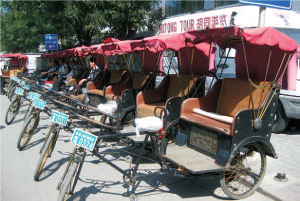 eijing’s restaurant scene is cosmopolitan. Indeed, when I asked my second-day guide, Clark Du, where I could sample a “typical” Beijing meal, he shrugged. He and his friends typically ate Italian or Japanese. I had good luck food-wise on my return to Beijing. In the spirit of full disclosure, I should mention that I stayed at the new Ritz-Carlton in the Financial District. The room was clean and sleekly comfortable and the food was very good. However, Chinese food still can range from good to bad to ugly. That being said, each meal—from the budget Jya-jiang noodles in a Hutong restaurant, to the steaming bamboo baskets of pork and crab dumplings in a fluorescent-lit shopping mall, to the bean curd and seafood served in a former Imperial garden by waitresses in Manchu robes—has its rewards. You do need to be choosy when dining out, as some aspects of Chinese food—and restaurant hygiene—are not for the meek. As a rule, I suggest staying away from spare parts.
eijing’s restaurant scene is cosmopolitan. Indeed, when I asked my second-day guide, Clark Du, where I could sample a “typical” Beijing meal, he shrugged. He and his friends typically ate Italian or Japanese. I had good luck food-wise on my return to Beijing. In the spirit of full disclosure, I should mention that I stayed at the new Ritz-Carlton in the Financial District. The room was clean and sleekly comfortable and the food was very good. However, Chinese food still can range from good to bad to ugly. That being said, each meal—from the budget Jya-jiang noodles in a Hutong restaurant, to the steaming bamboo baskets of pork and crab dumplings in a fluorescent-lit shopping mall, to the bean curd and seafood served in a former Imperial garden by waitresses in Manchu robes—has its rewards. You do need to be choosy when dining out, as some aspects of Chinese food—and restaurant hygiene—are not for the meek. As a rule, I suggest staying away from spare parts.
Steer clear of chicken or duck feet, tripe, and intestines, not to mention sea cucumbers and sea slugs. When I was there, th ere was hoopla about a funny story on Chinese food, sanitation and hygiene written by David Sedaris. To be sure, the non-hotel toilets can be daunting and require strong glutes and thighs. Use your imagination. Also, it’s a smart idea to carry you own tissue in case there’s a run on toilet paper. On the bright side, I think that, thanks to the Olympics, the Chinese have cleaned up their act with respect to uncovered hacking, phlegm-spitting and allowing babies to defecate in the streets. At least I didn’t notice it this trip. To many the hygiene is a deal-stopper, but to me, I say Vive la Difference. It’s all part of the great adventure that is China.
ere was hoopla about a funny story on Chinese food, sanitation and hygiene written by David Sedaris. To be sure, the non-hotel toilets can be daunting and require strong glutes and thighs. Use your imagination. Also, it’s a smart idea to carry you own tissue in case there’s a run on toilet paper. On the bright side, I think that, thanks to the Olympics, the Chinese have cleaned up their act with respect to uncovered hacking, phlegm-spitting and allowing babies to defecate in the streets. At least I didn’t notice it this trip. To many the hygiene is a deal-stopper, but to me, I say Vive la Difference. It’s all part of the great adventure that is China.

Photo credit: iStockphoto/Thinkstock
The laws of gravity and unintended consequences have collided in the New Jersey real estate market. The result is a warming trend in rental properties.

Photo credit: AVE/Kormanv
Throughout the United States, our jobs, our investments, our savings, our confidence, even our very homes are at risk. In New Jersey, the decline in home values since 2006 has changed the very complexion of the real estate market. And many professional predictions for 2012 forecast a continued downward trend. One of the consequences has been a rental boom, with some statistics indicating that vacancy rates in the third quarter of 2011 dropped sharply to 5.6%— the lowest level since 2006. Unfortunately, this has also led to a decrease in rental inventory and an accompanying increase in rents, which reached a median last year in the Garden State of about $1,500 for a one-bedroom. For any homeowner contemplating a move in the near future, the dilemma remains unchanged: Is it better to sell or stay? For everyone else, however, the question becomes: Does renting make more sense? The answer may surprise you.

Photo credit: AVE/Kormanv
A Different Animal In the gold-plated days before the economy tanked, the vast majority of renters in New Jersey were people who couldn’t (or chose not to) cough up enough cash for a down payment on a house or condo. Since many mortgage companies were offering loans with no or low down payment and a cursory credit check, almost everyone with a pulse could own a home. Today’s renter is a slightly different animal. One of the biggest barriers to home ownership is building a nest egg big enough to buy the nest. Among renters canvassed in a recent survey conducted by Trulia, an online real estate search engine, 51% confirmed insufficient down payments as the reason they had become renters rather than buyers.
Recently federal regulators have been suggesting that buyers must put down as much as 20% and sometimes even more. Right now, New Jersey has the highest average down payment rate in the country at 13.71% according to LendingTree. Some 36% blamed their inability to qualify for a mortgage as the reason they rent. Either their income was too low or their credit was sketchy. My, how things have changed. Job insecurity is another characteristic of the average renter’s profile.
An uncertain future makes relatively short-term rental and lease arrangements a preferable alternative to long-term home ownership. While owning over renting had long been the Holy Grail of real estate investing, the analysts who crunch these numbers now generally agree that purchasing a home in the current environment is the right move only if the property will be held for at least several years (the longer the better). For example, a buyer paying $400,000 for a home with 3% down and a mortgage under 5% will only start to come out ahead of a renter paying $2,000 per month after four years! This gives the “let’s wait-and-see” renter solid footing to continue leasing, even in a buyer’s real estate market. Of course, some people by nature are simply not cut out to be home owners. These individuals prefer to leave clogged drains and leaky roofs to the super or the landlord. Add to that our state’s high real estate taxes, and you have another reason why renting trumps owning for those who can afford to be choosy.

Photo credit: iStockphoto/Thinkstock
The Foreclosure Factor So where are we in the home-buying market, at least pricewise? According to the Case-Shiller Home Price Index released mid last year, home prices in Northern and Central New Jersey were down 24.2% from their 2006 highs, and down a more modest 3.4% from 2010 to 2011. Some experts believe that we could see the beginning of a rebound in 2012, or perhaps in 2013. More, however, are inclined to think that the market hasn’t bottomed yet. They cite an anticipated influx of foreclosures expected in 2012. The foreclosure factor is likely to have an impact on the rent vs. own decision, although which way it breaks is anyone’s guess.
The normal flow of foreclosures was impeded for a couple of years after it was discovered that some major banks were “robo-signing” key documents. It has taken a long time to go back and untangle the paperwork problems, resulting in tens of thousands of people being allowed to stay in their homes. Soon they will be hitting the street en masse—presumably as renters—while their homes will be vacant and available for sale or rent. What kind of numbers are we looking at? According to Michael Bonner, Founder and CEO of PropertyPilot, a real estate data and analytics company, there are over 150,000 properties in some state of foreclosure throughout New Jersey that will hit the market soon. This could put more downward pressure on home prices for the next year or two, making uncertain buyers much more uncertain. Many will undoubtedly opt to become (or remain) short-term renters.

Photo credit: AVE/Korman
Upscale Options With more people in New Jersey renting and new construction slowed to a crawl, the supply of apartments is dwindling. Which means that prices are likely to rise. Vacancy rates are tightening, with projections they will fall to 2.4% by the end of 2012. That means that for every 40 occupied units, there is only one empty and available. As a result, some developers are actually converting their for-sale condos into high-end apartments for lease. That should ease some of the supply-and-demand pressure. More important, it creates a new and appealing product for the shifting tastes and elevated expectations of the New Jersey renter. AVE, a division of Korman Communities (a pioneer in corporate housing), specializes in the suburban midrise residential rental market. Amy Barricelli, AVE’s Vice President of Marketing, confirms that the rental sector is on the upswing and describes New Jersey apartment-seekers as a “growing, savvy and discriminating” clientele. AVE’s hybrid business plan offers both furnished and unfurnished apartment units.
The former are available on a daily-rate basis for relocations and professionals in between homes. The latter are distinctive, yet reasonably high-end with an average monthly rent of $2,000 for a one-bedroom. For that price, residents enjoy a friendly home-like environment filled with healthy and high-tech amenities and social activities. As to AVE’s typical renter profiles, Barricelli says that among the company’s three New Jersey communities, their current resident population includes some newly married, some recently divorced, some corporate types, some Gen-Xers and some boomers. All are looking for the bells, whistles and extra creature comforts that can be difficult to find in a typical rental property. Barricelli adds that Korman views New Jersey as fertile ground for future growth and development of this type of rental option.
A Home-Buying Comeback? As long as home ownership is part of the American Dream, it would be unwise to bet against a comeback. The coming wave of foreclosures may create a new surge of renters, however it will also reset prices in the housing market, and ultimately help to stabilize it. It will be interesting to see whether the homes snapped up in foreclosure end up in the hands of those American Dreamers, or whether savvy investors buy them and convert into rental homes. Who knows? There could be a rental bubble awaiting us. How ironic would that be? It is not as far-fetched as it seems. For now, the rental market seems to be flexing its muscle, although Standard & Poors has suggested that the current gap between buying and renting is narrowing. This could mean the only sure winners in real estate in 2012 will be the landlords, the smart investors, and the property managers. The one unalterable fact is that people need a place to live. And since home is where the heart is, these days it makes little difference whether it’s owned or rented.
It may be pea-sized, but they don’t call it the Master Gland for nothing.
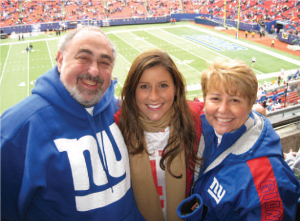
Irv Brechner joins daughter Stephanie and wife Nadine in the stands to root for his beloved Giants.
Talk to Irving Brechner sometime. He will tell you small does not mean insignificant. The tiny pituitary gland, located at the base of the skull between the optic nerves, controls hormonal functions that include thyroid activity, early growth, estrogen and testosterone production, and even body temperature. Brechner was struggling with several temperature issues—specifically feeling cold most of the time, but also having hot flashes. After initial consultations with his own doctor had yielded no definitive diagnosis, he turned in February 2011 to Trinitas doctors William McHugh (the hospital’s Medical Director) and Ari Eckman (Chief of the Endocrinology, Diabetes and Metabolism Division).
Under their thoughtful examination, a diagnosis was finally forthcoming. Although pituitary tumors may be present in as much as 20% of the population, they are usually so slow-growing and typically benign that they often go unnoticed. Not the case for Brechner. Initially, he underwent a progression of tests and bloodwork, which indicated certain hormone and vitamin deficiencies that were immediately addressed, but without the hoped-for improvement. Dr. Eckman described their evolving conclusion as “the results just didn’t fit right with normal pituitary functioning.” At that point, the doctors felt the situation warranted the next step in testing hierarchy—an MRI, which revealed a large mass that was interfering with proper hormonal production. Both doctors concurred that this growth was responsible for Brechner’s non-specific symptoms and discomfort.
Dr. Eckman referred to the results as “bittersweet…unfortunate that the tumor was there, but grateful that it was benign and surgically treatable.” Dr. McHugh and Dr. Eckman provided referrals to surgeons who were expert in this area. Brechner underwent successful surgery this past December. He was in-hospital for three days, after which he returned home and was able to resume his home-office responsibilities almost immediately. Brechner was unreserved in expressing his gratitude and admiration, and how impressed he was with the skill, the thoroughness, and the personal attention he had received at Trinitas from his two dedicated doctors. In fact, he summed up everything as “a wholly wonderful experience.” Especially since his accurate diagnosis and speedy recovery enabled him to attend the Giants’ victories over the Dallas Cowboys and Atlanta Falcons as they began their amazing run to the Super Bowl. Go Big Blue!
What’s the Smart Way to Deal with Menopause?
Trinitas psychologists Dr. Rodger Goddard and Patricia Neary-Ludmer discuss strategies for coping with the ‘change of life.’
Goddard: The topic of menopause is often taboo in our society. It is not the subject of lively dinner conversations or casual talk. It is not something that people automatically flip to in a magazine (or program into your DVR). We are more likely to hear about menopause as the punchline in a joke on TV or in the movies—tossed out to explain a woman’s frustration, unusual actions or bizarre behavior. It is unusual to encounter a frank, positive discussion between health professionals on this issue. In our society, youth and beauty are valued, worshipped and cherished. Aging and the intricacies of body changes and emotional states as we age are often pushed aside and shunned. Women undergoing menopause often take on our society’s view that something negative and bad is happening to them. Menopause can be made worse when it is viewed through the lens and prism of the media and the taboo assigned to it.
Neary-Ludmer: Then there is the additional stress of day-today life. A menopausal woman may very likely be working full-time, managing growing children, caring for her home and helping with the needs of senior parents—all while dragging around bone tired in a brain fog. Also, many of the symptoms of menopause, such as anger, mood swings and lack of sexual desire, can impact the marriage and family. If so, supportive psycho-educational counseling can be very helpful. This is an important phase of life. If we believe what we see and hear in the media, it can turn into something shameful or humiliating.
Goddard: Although it is accompanied by many difficult and potentially painful physical and bodily discomforts, the time of menopause can be embraced as a time of introspection, discovery, growth and valuing of the mysteries of life. It can be a time of bringing together the wisdom of a woman’s life and sharing that wisdom with others. It can be a time of creativity and connection to what is sacred and meaningful in life. The physical discomforts and pain of menopause can be dealt with and overcome. It is said that women are better at dealing with pain and discomfort than men. Menopause necessitates a woman coping not only with physical discomforts and pain, but also with the negative thoughts and emotions that our society assigns to it. Understanding menopause and finding positive, productive and creative ways to deal with it can make an incredible difference in a woman’s second half of life. Just as George Bernard Shaw said that “youth is wasted on the young,” it can also be said that aging is wasted on those who are unable to appreciate its special, new and sacred ways of experiencing life. One problem encountered by many women going through menopause is the tension that can occur between husband and wife. A husband may be insensitive, fearful of, or not able to understand menopause. Wives may feel inadequate, uncared for and less lovable. Communication and sensitivity are essential during this time.
Neary-Ludmer: Although the average age for menopause is 52, each woman has her own unique journey with this stage of her life. Each woman’s hormonal profile can differ in terms of estrogen, progesterone, and testosterone. Early menopause can be brought on, at any age, by medical conditions such as cancer treatments or hysterectomy. About 25 percent of women begin menopause this way. Scientists have also found that if there is a family history of early menopause, the woman is 60 percent more likely to enter menopause early. Strictly speaking, menopause means no menstruation for at least 12 months. Symptoms include sweats, hot spells, hot flashes, fatigue, mood swings, craving sweetness and carbohydrates, difficulty sleeping, joint pain, concentration and memory difficulties, thinning hair, increased facial hair and dry skin and eyes. It is important to understand that women may also experience perimenopausal symptoms. Perimenopause refers to the time period where menstruation is still taking place but the female hormone levels are beginning to shift. Symptoms can be subtle to severe. Perimenopause can last months…or as long as a decade.
Goddard: It is important to be on the lookout for menopause problems that may be excessive and beyond what is expected. Women should not hesitate to see a doctor on a regular basis during menopause. Keep in mind the frequency, duration and intensity test: If your symptoms seem to occur more frequently, last with greater duration or have much greater intensity than what you would expect, see a doctor. Menopause brings with it many confusing and difficult decisions concerning whether to use Hormone Replacement Therapy and/or other special medication, herbal, supplement or dietary remedies. For example, Dr. Andrew Weil, a pioneer in integrative medicine, suggests that menopausal women should increase their intake of omega-3 fats, as they help to lessen the hot flashes and depression that may occur with menopause. The key is to be diligent, stay in control, investigate and determine what is right for you based on sound research. When is comes to any health issue or medical problem, the more information we have, the easier it is to make a decision. In fact, research shows that, in general, the more active a stance we take and the more we exert conscious decision-making and control over a medical issue, the more positive the outcome.
Neary-Ludmer: The most important active step you can take during menopause is to find a trusted doctor to perform a thorough medical evaluation and guide you through this time. In addition to Hormone Replacement Therapy, there are several options to consider. They range from low-dose birth control pills to help with mood swings to getting into a regular yoga or exercise routine to adjusting your diet and sleep patterns. Beyond the physical, of course, are the emotional issues.
Goddard: Think body mind-heart-soul. Taking care of our bodies involves eating health foods and controlling our stress levels. Menopause often necessitates a change in diet and renewed efforts to control our stress. Menopause can bring with it tension and anxiety. It is good to strengthen our ability to reduce tension, anxiety and stress. This can be done by learning how to calm ourselves throughout the day, doing a daily yoga routine and using deep mindful breathing throughout the day to calm ourselves down. Regular exercise has also been found to help decrease the negative effects of menopause. Taking care of the mind involves identifying and solving problems, as well as clarifying what is most important to us and taking the actions necessary to achieve those most cherished goals. It also involves using productive and tough thinking to fight against our negative emotions and thoughts. Taking care of the heart involves getting support from others and dealing with our emotions in productive ways. Women should find ways to have open discussions with husbands, boyfriends or partners during this time period. Taking care of the soul involves nurturing ourselves and treating ourselves with extra care. Being creative, pursuing your passions, communing with nature, taking time to meditate and connecting with the beautiful and sacred things in your life is important.
Neary-Ludmer: At the same time, it’s also important not to minimize or underplay the impact of menopause. This can be a 10-year process, and a chapter of a woman’s life that is often accompanied by insults to her self-image, feelings of increased vulnerability and insecurity. Women need support and encouragement to negotiate the body changes and emotional ups and downs. Lastly, they need to be reminded that post-menopause can be an exciting chapter of their lives. They will feel renewed and empowered.
Editor’s Note: Dr. Rodger Goddard is Chief Psychologist at Trinitas and Director of the hospital’s wellness program which provides companies, agencies and schools with onsite programs to improve health and productivity. Dr. Patricia Neary-Ludmer manages the Family Resource Center in Cranford, which is affiliated with Trinitas’s Department of Behavioral Health and Psychiatry.
Why is There an Adderall Shortage? A shortage of the stimulant Adderall has parents of children with Attention Deficit Hyperactivity Disorder (ADHD) scrambling in the new year. The problem stems from DEA policies aimed at preventing the stockpiling of controlled substances, which are often diverted for inappropriate use. In the case of Adderall, it has become popular with students hoping to improve test scores. The DEA determines how much of the stimulant is released to drug manufacturers based on what it considers to be legitimate use. The agency has fired back at drug companies, which it claims have elected to manufacture more expensive brand-name pills instead of generics, which in turn contributes to supply-and-demand problems. “I am very concerned about the future,” Ruth Hughes told Reuters in January. Hughes runs Children and Adults with Attention Deficit Hyperactivity Disorder. “No one seems to have much inventory to get us through the months ahead.” As many as 20 million prescriptions for Adderall were written in 2011.
Inside the New HIV/AIDS Numbers  You may have heard some encouraging news over the holidays about the fight against HIV/AIDS. The United Nations announced that both AIDS-related deaths and new HIV infections have dropped to their lowest levels since the peak of the epidemic in the 1990s. Worldwide, new infections have dropped 21% since 1997 and deaths were down 21% since 2005. Researchers credit a combination of things for the dramatic improvements, including scientific breakthroughs, access to treatment, better political leadership and social change. The UN report also noted that HIV-infected individuals are also living longer.
You may have heard some encouraging news over the holidays about the fight against HIV/AIDS. The United Nations announced that both AIDS-related deaths and new HIV infections have dropped to their lowest levels since the peak of the epidemic in the 1990s. Worldwide, new infections have dropped 21% since 1997 and deaths were down 21% since 2005. Researchers credit a combination of things for the dramatic improvements, including scientific breakthroughs, access to treatment, better political leadership and social change. The UN report also noted that HIV-infected individuals are also living longer.
Wait a While…and It Won’t Go Away A recent news story about a 44-year-old hospital worker who waited too long to address symptoms of severe  abdominal cramping underscores the importance of catching colon cancer in its early stages. This individual, who was literally surrounded by doctors every day, put off a visit to his GP until the condition became unbearable. When he finally had it checked out, he was diagnosed with metastatic inoperable carcinoma of the colon. Colon cancer is the third leading cause of cancer-related death for both men and women. Yet it is 95 percent curable if diagnosed before symptoms arise. Most colorectal cancer begins as a non-cancerous (benign) adenoma or polyp (abnormal growth) that develops on the lining of the colon or rectum. Polyps can be removed to significantly reduce the risk of cancer.
abdominal cramping underscores the importance of catching colon cancer in its early stages. This individual, who was literally surrounded by doctors every day, put off a visit to his GP until the condition became unbearable. When he finally had it checked out, he was diagnosed with metastatic inoperable carcinoma of the colon. Colon cancer is the third leading cause of cancer-related death for both men and women. Yet it is 95 percent curable if diagnosed before symptoms arise. Most colorectal cancer begins as a non-cancerous (benign) adenoma or polyp (abnormal growth) that develops on the lining of the colon or rectum. Polyps can be removed to significantly reduce the risk of cancer.
Colonoscopy plays an important role in colorectal cancer prevention because precancerous polyps can be detected and removed during the same exam. The American Cancer Society suggests a colonoscopy after the age of 50 for both men and women. “A normal colon means you will not need another colonoscopy for another ten years,” says Dr. Samiappan Muthusamy of the Center for Digestive Diseases. “If you have a family history of colon cancer, especially a close family member who was diagnosed before the age of 60, then a colonoscopy is recommended at the age of 40.” According to Dr. Muthusamy—Clinical Assistant Professor at Seton Hall University and past Chief of Gastroenterology/Endoscopy at Trinitas RMC—colorectal cancer screening tests are covered by Medicare and, under a new Affordable Care Act provision, private insurers are now required to cover the entire cost of screening colonoscopy.
 E-Shoppers Under the Influence One of the most unusual trends to emerge this past holiday season was a sharp rise in “drunk shopping.” Drunk shopping is exactly what it sounds like. People have a couple of drinks, go online, and start buying things they normally wouldn’t. E-tailers know this is happening. They can tell when someone orders 10 of something instead of one—they have impatiently clicked the BUY button too many times. Another sign is when shoppers botch selections from a drop-down menu, such as which state they live in.
E-Shoppers Under the Influence One of the most unusual trends to emerge this past holiday season was a sharp rise in “drunk shopping.” Drunk shopping is exactly what it sounds like. People have a couple of drinks, go online, and start buying things they normally wouldn’t. E-tailers know this is happening. They can tell when someone orders 10 of something instead of one—they have impatiently clicked the BUY button too many times. Another sign is when shoppers botch selections from a drop-down menu, such as which state they live in.
Online giant eBay saw a huge spike in shopping between the hours of 6:30 and 10:00 on weeknights, and has gone on record that alcohol is absolutely a factor. The home-shopping channels saw a big bump in impulse purchases of makeup and accessories by its core customer in the evening hours, too. “You can probably come to your own conclusion as to what’s motivating her,” said a QVC rep. Online retailers added fuel to the fire in December by holding their most enticing promotional emails until after 9:00 p.m. Shoppers who’d had a drink or two were more likely to drop an item into a make-believe shopping cart and follow through with a purchase of something they didn’t necessarily want or need.
Underactive Thyroid at Center of Pregnancy Debate For a good decade now, it has been widely accepted that an underactive thyroid can raise a woman’s  risk of miscarriage, underweight birth, or diminished IQ for her baby. Doctors know to treat severe cases with hormone medication, but there is a growing debate about how to handle milder “gray-area” cases. Roughly a quarter of pregnant women receive a thyroid blood test whether they have symptoms or not. Testing lab Quest Diagnostics recently reported that about 15% of the expectant mothers it tested showed signs of an underactive thyroid, which surprised many. An underactive thyroid (aka hypothyroidism) slows body functions, causing such problems as fatigue, weight gain and depression.
risk of miscarriage, underweight birth, or diminished IQ for her baby. Doctors know to treat severe cases with hormone medication, but there is a growing debate about how to handle milder “gray-area” cases. Roughly a quarter of pregnant women receive a thyroid blood test whether they have symptoms or not. Testing lab Quest Diagnostics recently reported that about 15% of the expectant mothers it tested showed signs of an underactive thyroid, which surprised many. An underactive thyroid (aka hypothyroidism) slows body functions, causing such problems as fatigue, weight gain and depression.
The obvious question is, are the three-quarters of women who are not getting tested being put at risk? As many in the field have pointed out, the effects of mild hypothyroidism on pregnancy—and the correct treatment—are unclear. “There are studies on both sides of the fence,” points out Dr. Dena Goffman of Montefiore Medical Center in New York, which tests only women it considers to be at high risk. “If you don’t know what to do with the results, you probably shouldn’t order the test.” The American College of Obstetricians and Gynecologists recommends testing only pregnant women who have thyroid symptoms, have had previous thyroid problems, or have similar auto-immune diseases. The American Thyroid Association suggests testing all pregnant women age 30 and older, and those with enlarged thyroids, previous pregnancy problems or who are obese.
Diet & Exercise Lower Breast Cancer Risk Women need not feel powerless against breast cancer. Scientific evidence shows that women do have the power  to protect themselves by staying slim and active, focusing on healthful, natural foods, and avoiding the disease-causing foods common in the standard American diet. According to Dr. Joel Fuhrman, author of Super Immunity, the keys to a cancer-resisting diet include getting your folic acid from green vegetables (as opposed to the synthetic type contained in multivitamins and prenatal vitamins); taking a daily dose of ground flaxseed (which contains estrogen-blocking lignans); eating your GOMBBS (greens, onions, mushrooms, beans, berries and seeds); minimizing the consumption of meat, fish and dairy products, and avoiding white flour and sugars.
to protect themselves by staying slim and active, focusing on healthful, natural foods, and avoiding the disease-causing foods common in the standard American diet. According to Dr. Joel Fuhrman, author of Super Immunity, the keys to a cancer-resisting diet include getting your folic acid from green vegetables (as opposed to the synthetic type contained in multivitamins and prenatal vitamins); taking a daily dose of ground flaxseed (which contains estrogen-blocking lignans); eating your GOMBBS (greens, onions, mushrooms, beans, berries and seeds); minimizing the consumption of meat, fish and dairy products, and avoiding white flour and sugars.
Obesity is a strong risk factor for breast cancer, Furhman says, adding that a higher body mass index (BMI) is associated with higher estrogen levels, a risk factor for breast cancer. Besides a smart diet, exercise is critical. An analysis of 73 different studies recently concluded that women with high levels of physical activity reduced their risk of breast cancer by 25%.







Everyone in New Jersey thinks they can run an Italian restaurant. I don’t think I want to.
Being part of an Italian restaurant is all I’ve ever known. I was born into a generational, family owned business that has been operating for more than fifty years. My grandfather’s dream was my playpen. Literally. Warm smiles were usually accompanied by a pignoli cookie or a cannoli. The servers were like aunts, uncles and cousins. What a fabulous and affectionate way to spend my childhood. It was not a life of privilege in the conventional sense. I wasn’t born with a silver spoon in my mouth. But a wooden one suited me just fine. Of course, the reality of the business eventually climbs into your life. My childhood Candyland was a living, breathing, hectic restaurant. And it wasn’t always sunshine and dreams. My first real job in the restaurant took place at the tender age of 13. Twice a week, for a total of four hours, I labored in the bakery. That time was primarily spent pouting, standing along the wall, brushing crumbs onto the floor and trying to look busy whenever my parents walked in. All the while, the actual workers were glaring at me. I wasn’t helping. I was in their way. Other kids I knew got grounded when they did something wrong. I was forced to help the hostess on busy Saturday nights. I did more moping than greeting. Ironically, when I look back, I would have to say hostessing was my favorite duty. It required the least amount of actual movement or labor, and I got to stand there looking all dolled-up for a few hours. Working in the bakery would come in second, since all I really had to do was fold cake boxes, weigh pastries, hand customers breads or pizzas,
and assemble cookie trays (so that one extra would land in my mouth). My least favorite (and current) duty is waitressing. Although it is the highest-paying job in the restaurant, at the end of a shift I am covered with grease and alcohol, my head is filled with customers’ complaints and I am dog tired. Being a waitress is really hard work. This is compounded by my natural talent for messing up orders, dropping plates and spilling drinks on patrons. Once I was blind-sided by a negative review of my service after I thought I had done an amazing job with a table. The customers’ actions and generous gratuity seemed to confirm this, yet they smack-talked me on the way out to my manager. That was an especially low blow to my ego. Although being part of a restaurant family has its occasional perks, family members tend to get the short end of the stick compared to the employees, particularly when it comes to the more unpleasant jobs.
There have been numerous instances where I’ve had to get down and dirty. Really dirty. When there’s a clog in the restroom, it always falls to a family member because we can’t say, “I quit!” Also, if I have an amazing date on a Saturday night, or maybe I’m just having one of those days, can I call in and say I’m a no-show tonight? Fugghetaboutit. Can they call me in on my day off because someone else left them hanging? Absolutely. So here I am, a struggling writer with a handful of clippings and a college diploma, looking to get out of the restaurant business as soon as I can afford to. It’s not a decision I came to easily. To take over the family business and continue the Piancone legacy would put a colossal beam on my father’s and late grandfather’s faces—especially since I am an only child and the oldest of seven cousins. Although pride would be coursing through their veins, my family members completely support and understand my need to pursue the career of my choosing. And needless to say, without the help from my family and the restaurant, I would not have been able to receive my undergraduate degree, or be able to put money aside for graduate school. Of course, this is New Jersey, so there’s always someone out there dying to run an Italian restaurant. If that’s you, my advice is to involve your extended family—but also to go in with your eyes wide open. You will need a family that is at least semi-stable, and always ready to man-up and hold down the fort. For what it’s worth, here are some additional words of wisdom:
Treat Family & Workplace Like Church & State. No one wants to talk or think about work after they’ve made it back to the sanctuary of the home. Imagine being overworked and exhausted and then having someone—I won’t mention any names, Mom—asking an endless series of rapid-fire questions. Was it busy? How much money did you make? What’s your schedule? How did the food look? Were there a lot of people at the bar? By the same token, everyone needs to leave work baggage at the door. This is definitely easier said than done. It is also inevitable that your personal life will clash with your work life. Expect it, but don’t invite it. Bottom line? Separate home and work problems. Long-term it’s the only successful route to take.
Respect the Pecking Order. The boss is the boss, the chef is the chef, and family members need to fit in to make a place run smoothly. As the boss’s daughter, I got treated differently. The chefs were nice to me even though, as a rule, they don’t have such a peachy demeanor. On the flip-side, no one wants to include you in small talk. It’s amazing how kitchen conversations suddenly end when I pop my head in and say, “What’s up, guys?”
Don’t Take It Personally. If a customer is unhappy with the food or gripes about the service, chances are he or she is complaining about a family member. Let it go. Stay calm and respectful, even if your stomach is tied in knots. Everyone has an off day, including Mom and Dad. In my case, there’s an added twist since my boyfriend works in our restaurant. When a customer calls him a cutie pie, I need to tell myself servers and patrons are always flirting. Again and again and again. All kidding aside, the Piancone family has experienced business and personal success due to our genuine love and passion for the restaurant and one another. Unlike a corporate work environment, our staff is made up of handpicked prodigies that we know truly care about the well-being of the restaurant because they are our best friends. Our church and state may continuously clash, and a few customers may give us grief, but at the end of a long night, we know we’ll come together and share a glass of wine. Which, believe me, beats the heck out of those pignoli cookies.
Editor’s Note: Johnny Piancone (johnnypiancone.com) is located on Broadway in Long Branch. Francesca’s grandfather and his brother started in Bradley Beach in the 1950s. Francesca graduated from Lynn University in Florida. She wrote for Gold Coast magazine before joining the EDGE family.
The Cold, Hard Fact
New Jersey’s number-one export is college-bound seniors. During each application period, the nation’s top colleges are flooded with applications from the Garden State. It’s a numbers game that works against our kids. However, if you do a little homework, there are definitely ways to make the numbers start working for you. So with the dark winter of college acceptance letter anticipation upon us, let’s look back at the 2011 application period and see what it has to teach next year’s juniors and seniors. First things first. For the mournful applicants who threw their hats in the Early Decision ring at Ivies such as Brown University—which accepted only 900 of the 2,900 applications—ED now stands for Early Disappointment. Ditto Northeastern, which deferred an inordinate amount of highly qualified Garden Staters. The story was the same in one popular school after another. Indeed, many of our young and talented “intellectual-istas” are now pacing the library aisles hoping that fat envelope shows up in April…and wondering what went wrong. What went wrong is that they all chased after the same hot colleges, essentially forcing the hands of admissions officers to say No. Geographical diversity is a high priority at most top schools. Translation: we can only take so many kids from New Jersey. How do you swing those odds in your favor? That process starts during the critical first steps in the college search and application process.

Photo credit: iStockphoto/Thinkstock
MANAGING EXPECTATIONS In order to have successful outcomes, an ounce of expectation management is worth any of those one-pound college guides you’ll be buying at the local Barnes & Noble. Understand where your college-bound child fits into the overall admissions picture. For instance, while GPA is a healthy indicator of a student’s success in college, a 3.0 at The Lawrenceville School is quite different than a 3.0 at nearby Trenton Central High School—with due respect to both. Standardized test scores are also useful in helping a student (and more importantly his or her parents) determine whether or not the student is likely to be admitted or likely to be rejected by a given college. Beyond those quantitative indicators, one must acknowledge that college-admission decisions can also turn on relationships. In addition to an “in” or connection at a school, however, students must also demonstrate a knowledge of the culture and mission of that college—and articulate that interest throughout the application. To do so, successful applicants must really know the colleges to which they are applying. And if that school is a “hot” school, well, they really need to bring their A-Game to the application.
IDENTIFYING A HOT COLLEGE Long before work begins on applications, you can start creating a wish list of schools. That list will almost certainly be populated by a number of hot colleges. That’s fine and that’s fun, but look at those schools and ask yourself, how many of them were popular five or ten or fifteen years ago? Where I’m going with this is that there are a lot of schools right now primed to “join” the hot list. Your job is to identify them before everyone else does. Beating the competition to a hot college is much like picking a stock. First, observe how the school performs over a period of time. Frankly, this is one of the major reasons families come to people in my business. Educational consultants visit numerous college campuses, read The Chronicle of Higher Education and other pertinent periodicals, attend symposia and present at conferences, and nurture ethical relationships with admissions representatives—all on their clients’ behalf. Of course, you can “day-trade” and do the work yourself. Begin by identifying and tracking a college of interest. Some points to consider are: Has this school made a jump in rankings and/or is it rankings-aware? Has there been a recent shift in leadership? Are the current students and grads singing the school’s praises? How strong are the career services and what companies recruit on campus? This information isn’t always easy for a layperson to access or understand, but the more you amass, the better your results will be. One good publication that is literally the length of a church bulletin is the CollegeBound newsletter (collegeboundnews.com), which is very readable and provides real-time admission numbers. I tweet these bitesize stats daily.
NAMING NAMES Without specifically advocating these institutions as bestfits for any individual, here are a couple of examples of what I’m talking about. Ever heard of High Point University, in North Carolina? If not, you will. I have been following High Point for some time now. It has all the earmarks of a hot college due to the leadership of its president, a former CEO with a business-savvy approach to student satisfaction and success. The graduating senior entering just four years ago probably would not be accepted this year in the Early Action pool. Size, location and price-point make this college one to watch. Closer to home, I also like what I am seeing at Drexel University. It stands out among the growing number of colleges offering co-op opportunities. Co-op stands for “cooperative,” which is an option at some colleges that enables students to earn course credits for work experience in the form of approved internships (which are frequently paid!). This option is best suited toward pre-professional students who are actively preparing for a career in a specific field, learn-by-doing students, and students who want “a foot in the door.” An inordinately large number of students are hired by the firms at which they completed their co-ops. It’s not hard to see why schools offering co-op programs have seen their popularity and demand rise over the course of the past three years—while at the same time the precarious economy has called into question the value of the liberal arts education in favor of a skill- and career-based undergraduate education. Making industry connections and building up a résumé all appear to be de rigeur at this juncture, but as a purist, I beg to differ that the liberal arts and sciences are passé. In favor of this argument, take Bucknell University. Tucked away in Western Pennsylvania, this Division I college has grown extremely selective in its admissions decisions over that past decade. The emphasis on interdisciplinary study and engaged learning is helping Bucknell produce superlative leaders and self-starters.

Photo credit: iStockphoto/Thinkstock
DOLLARS AND SENSE As college costs skyrocket and family budgets tighten, the “default” pick for many students is the state school or community college. However, that is not necessarily where the higher-education bargains are. Indeed, the changing economy has created some eye-opening options—and potentially an entirely new class of hot colleges. Parents of 10th and 11th grade students at this juncture may want to consider the fact that most students at independent institutions pay less than the published tuition price. According to College Board’s “Trends in College Pricing,” the average student paid $17,000 less than the sticker price at independent colleges and universities in the U.S. in 2010-2011. How is that possible? Federal grant aid for students at state schools is about $3 billion a year. Meanwhile, institutional grants—the free money given to students by the colleges they attend—is around $20 billion! So opting for the state university or community college without exploring the estimated cost after Gift Aid could cost you in the long run. Gift Aid is free money for college that students do not have to pay back. It comes in the form of tuition discounts off the sticker price for attractive applicants. A strong academic profile and high-test scores—which will in turn boost a college’s rankings—are two reasons why colleges would offer Gift Aid to an applicant. By the way, as of last December a mandatory net price calculator must appear on all college web sites. This is a groundbreaking change intended to help families get an early read on the true cost of college. Though each site’s calculator will vary, some will calculate Gift Aid. The bottom line is that the college application process can be a messy one, but it’s definitely manageable. Of the many things that are crucial to keep in mind, perhaps the most important is that college is not a one-size-fits-all prospect. The right school, hot or not, is out there for your collegebound son or daughter. The more effort you put into identifying that school, the better your chances for a positive outcome.
Editor’s Note: When Erin is not authoring articles, she runs Avery Educational Resources (averyeducation.com). She also does pro bono work with children who lost parents on 9/11. A Division I varsity athlete and a competitive Irish step dancer, she holds two Master’s degrees from Oxford and Yale Universities, respectively.
Anyone who questions whether acting is a craft needs to spend a little time with the cast of a play like Stick Fly, which opened to rave reviews this past winter at the Cort Theatre on 48th Street. Produced by Alicia Keys and directed by Kenny Leon, Lydia Diamond’s engaging family drama explores themes of race and class through the story of an upper-class African-American family. While this may be unfamiliar territory for most Broadway theatergoers, the two male leads of Stick Fly are instantly recognizable. Mekhi Phifer (ER) and Dulé Hill (The West Wing and Psych) rank among the most beloved and talented ensemble television actors of our time. Hill is an old hand where Broadway is concerned, while for Phifer Stick Fly marks his debut. EDGE Assignments Editor Zack Burgess met with the co-stars before a performance at the Cort over the holidays. Three-way Q&A’s can be tricky—especially with so much ground to cover—but as usual, Zack just pointed his subjects in the right direction and they took it from there.
EDGE: Did either of you have a professional relationship with Alicia Keys prior to this production of Stick Fly? Dulé Hill: No. But I have always been a fan of hers. Who’s not a fan of hers? Mekhi Phifer: I knew her, but of course not to the level of our friendship since this project got started.
DH: I had done a version of Stick Fly about five years ago in L.A. It was a staged reading with mikes. It kind of reminded me of old-school radio. It was fun. I hadn’t thought about it since then, and then I got a call back in the summertime to do a project. I knew they had an offer out to Mekhi, which really piqued my interest. Once I was told the name of the play, I said I’m in. Alicia’s involvement was the icing on the cake.
EDGE: You both have done lots of television and film work so you have a good background in terms of shared experience. The exception is probably that Dulé has spent time on the Broadway stage. Mekhi, how has Dulé helped you adjust to performing on stage?
MP: Dulé has done Broadway four times. I’ve never done a play, so I’ve asked him a lot of questions. It’s always helpful to be surrounded by people who are veterans and who are good at what they do—who know what is entailed in making this thing work. Being able to go to Dulé was very helpful for me to get acclimated to this environment.
DH: Remember that the other pieces have mostly been musicals. This is only the second produced play that I have done. So it’s still kind of a new world for me. I’m not going to be putting on any tap shoes or singing.
EDGE: Dulé, what did you see as Mekhi’s immediate strengths in terms of stagework when you guys started rehearsals back in the fall?
DH: It comes down to being a brilliant actor. He brings it every time. That’s the case whether he’s on ER playing Dr. Pratt or the star of Paid In Full, coming on Psych or playing Flip in Stick Fly. That alone is it. Having those skills. There are things you have to do when you’re dealing with the stage versus film and television, and Mekhi took everything in, learned and adapted. He asked questions and processed information very quickly. You wouldn’t know that this is the first play he’s ever done. I really respect him for that.
EDGE: Dulé, are there any parallels between the LeVay Family in Stick Fly and your own experience growing up in New Jersey?
DH: I grew up in a middle-class family, although I don’t think we had anywhere near the type of money of the LeVays. But I definitely relate to the LeVays’ dysfunction. I have a great family, but we have our level of dysfunction, too. There are things we don’t talk about. We don’t always address issues when we should and they end up simmering underneath and then exposing themselves in other areas.
EDGE: What about similarities to your character, Spoon?
DH: Spoon is trying to figure out where he wants to go in life. And that is foreign to me because I started doing theatre at the age of ten, and started tap-dancing when I was three. I’ve always been on a journey of self-discovery and owning who I am as Dulé—not trying to fit into the mold of what other people think I should be. Spoon doesn’t own his vision. He starts to figure it out during the play, but in a way his family never supported him or gave him the opportunity to really find out what he wanted to do. I’m very thankful that my parents supported me, exposed me to new experiences and let me find where I want to go in life.
EDGE: Is that what Stick Fly is about?
DH: It’s about family dysfunction, self-identity…and daddy issues.
EDGE: Daddy issues in what respect?
DH: The idea that, when you’re a child, your father is perfect. For instance, I love my dad to death, but growing up there’s this issue of trying to fit into the mold of who you think you should be because of your father. Then one day you realize that your father is a man just like you. He has his own faults and Achilles’ Heel.
MP: My character, Flip, emulates his father. He’s a doctor, like his dad. He’s just living life. He’s off the cuff. Flip has what is seemingly a closer relationship with his father than the one Spoon has. But I think what makes Dulé’s character stronger than mine in certain respects is that Flip took the more accepted route by becoming a doctor.
EDGE: What was your family background like, Mekhi?
MP: I grew up in a single-parent home and never met my Dad. At the same time, my mother was a schoolteacher, a dancer and a choreographer. She always stressed academics, but she was also about the arts. There was never one way to do something. She favored an obtuse way of thinking versus an acute way of thinking. So my mom wanted me to have great grades and she looked over my homework. But she was always supportive of the arts. So when I was a kid and I would do little talent shows, or rap in freestyle and battles, she was always very supportive.
EDGE: What nuggets of wisdom have you guys picked up from your co-stars over the years?
DH: We’ve worked with phenomal co-stars.
MP: I agree, we’ve both been blessed to work with some dynamite co-stars.
DH: On The West Wing, Martin Sheen used to say to me, “It’s got to cost you something. If it doesn’t cost you something, then it’s meaningless.” Whether it’s the journey of the character or you as an individual, you really have to put yourself into it. Something—time, energy, whatever— has to be sacrificed if you’re going to have a successful career. For example, if I’m hanging out all night partying and then try to come on stage the next day, it’s just not going to work. You have to make choices and say, “This is where I want to go. This is what I want to do.” That always stuck with me. What also struck me about Martin was his humanity, how personal and gracious he was with everybody. I try to take that part of him and apply it to my own life.
MP: The first piece of advice that really stuck with me came while I was doing my second film, Tuskegee Airmen. Laurence Fishburne told me then that “less is more”— especially when you’re dealing with film and television. Another piece of advice I got was from Bill Cosby. He said somebody had asked him what was the key to success, and he said he didn’t know, but he did know the key to being unsuccessful, and that’s trying to please everybody. Those two poignant statements have stuck with me throughout my career.
EDGE: From Martin Sheen and Laurence Fishburne we move on to Jon Lovitz…Mekhi, what do you take away from a crazy comedy like High School High?
MP: Jon Lovitz was wonderful. We were all young in that movie and I always remember him being so nice. He was extremely successful at that point, just coming off of doing SNL. That was early in my career and it was a little bit of a whirlwind for me. But Jon’s one of those guys that will stop you on the street and talk to you, and after awhile you’ll be like, All right Jon, enough is enough. Enough jokes. I’ve got to go. So like Dulé said about Martin, yeah be successful, but be gracious as well. Live life and get to know more people.
EDGE: Dulé, you got to know Wesley Snipes working together on Sugar Hill. What insights did he give you as an actor?
DH: There was one thing that Wesley told me that stuck with me. I had just gotten to L.A. and it was right before I got The West Wing. I was auditioning for stuff and I wasn’t getting the roles, the scripts weren’t very good, and I was going to get dropped by my agent. I ran into Wesley one day and he said, “If there’s always one way, there’s always another.” I asked him what he meant by that and he explained that if you see a bunch of people going up a hill and falling back and not making it through, then try to look on the other side. There’s not just one way to get to your destination. I don’t know what he meant for me to receive from that, but it always stuck with me. From then on I’ve always looked for different angles on how I approach a character, and my career.
EDGE: I am curious how the involvement of a major musical personality changes the culture of a movie or a TV show or a stage production. For instance, Mekhi, when you worked with Eminem on 8 Mile, was that a very different experience than the other films you’ve done?
MP: It was great. Pure fun. I’m 26, 27, we’re in Detroit, Eminem is at the apex of his career. We had a month of rehearsals so that Eminem could get dialed in. We partied hard and it was fun. It was a great experience working with a director like Curtis Hanson and all these actors who were relatively unknown at the time. We had a blast. What I loved about Curtis was that he trusted us. Even when we were doing the battles—that stuff was not scripted. And the people in Detroit were great. What made those battle scenes real is that those people were real people. They were not day-to-day extras, they were real people from the neighborhood.
EDGE: Every successful actor has that role that he almost got, but it went to someone else. So tell me, each of you, what was the “one that got away”?
DH: That’s a tricky question, because if it got away then it was never really mine. There are roles throughout my career that I wanted, but I’m very happy for the actors who got them. One was Savion Glover’s role in Tap, because I’m a tap dancer. To work with Gregory Hines, Steve Condos, Harold Nichols, Jimmy Slyde and Sammy Davis, it really hurt when I didn’t get it. I just wanted to be in that space with those great actors. A lot of those guys started passing on right after that. Antwone Fisher was another role I really wanted. I would love to have shared the screen with Denzel Washington for that amount of time. Derek Luke got the role and Derek’s a good friend of mine. It really exploded his career. I was happy for the actors who got those parts, but I would be lying if I said I hadn’t wanted those roles.
MP: Right after I did Clockers with Spike Lee, I auditioned for Dead Presidents. I was right down to the wire for the role of Anthony and they decided to go with Larenz Tate, which was fine because Larenz is a friend of mine. They were shooting in New York, it took place in the Bronx, and the Hughes brothers were just riding high off Menace II Society. I remember meeting with the casting director, who thought they were going to give me the part. But I guess the Hughes brothers already had a relationship with Larenz—who had stolen the show in Menace II Society. I guess they figured We’ll ride with him.
EDGE: Have you ever walked out of an audition thinking you’d messed it up?
DH: Going back to Antwone Fisher, I got a chance to read with Denzel. Now normally after I read a script, I don’t usually get caught up in the things that are in parentheses— words like ANGRY or UPSET. I leave that alone and go with my own journey. For some reason in that particular situation, I saw the word ANGRY sticking out. So when I’m in the room and it’s me with Denzel, that word kept popping into my head. So I’m reading and I’m being angry. The first thing Denzel said to me was, “Why you so angry?”
EDGE: But your career survived.
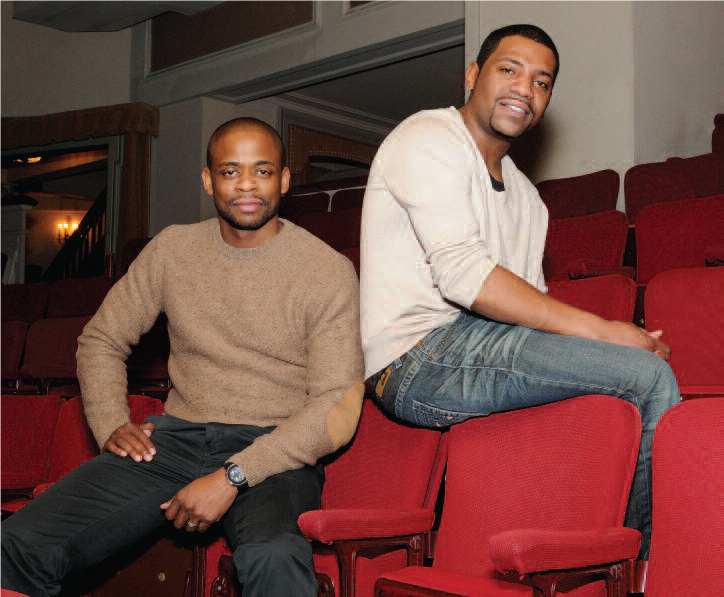
Photo courtesy of Nadine Raphael
DH: It did. So to all the people out there, I say just because you mess up on one thing doesn’t mean it’s the end of the world.
EDGE: Back to Stick Fly—Dulé, how does this cast compare to some of the others you’ve worked with?
DH: One of the perks of being in this business is just the camaraderie that exists with the people we work with. That’s what makes a show like Psych successful. These people are really good at what they do. And they also happen to be really nice people—people that you want to hang with and have drinks with later. Look at Stick Fly. When you work with actors like Ruben Santiago-Hudson, Tracie Thoms, Rosie Benton—they challenge you just to step up to another level. Ruben is a bona fide professional veteran, Tony Award winner and dynamic actor. You can’t half-step it with Ruben. It’s not going to happen. They’re all phenomenal actors. Then you get blessed to be in a situation where you’re seeing someone like Condola Rashad—someone who is already great, but her career is just getting started. I’m really honored to be on the stage with her. She’s knocking it out of the park now, but in ten, fifteen years I truly believe I will be saying that I was a part of her journey to greatness.
EDGE: What does your director, Kenny Leon, bring to the show, and how might someone in the audience at Stick Fly experience that?
MP: Kenny brings a realism to it. I’ve been to many Broadway shows and the worst thing in the world is to sit there and you’re bored out of your mind. You start fidgeting, you start falling asleep. Kenny not only stresses pace, but telling a story and being good at what you do as an actor. A good analogy would be a dog race. We, the actors, are the rabbit. The audience is the dog. We want them to come up to our speed, and I think we succeed. Doing a play is a totally different machine when it comes to directing. I love Kenny’s direction.
DH: I have to say that most of the directors I have had a chance to work with have been brilliant. But there are things about Kenny that remind me of George Wolf, the director of Bring in ‘da Noise, Bring in ‘da Funk. They are both very specific about every little detail. Everything we’re doing on stage in Stick Fly is meant to draw the audience’s attention to where Kenny wants it to be. That’s cool, because sometimes as an actor you forget those things.
Editor’s Note: Zack Burgess writes about politics, sports and culture for a variety of publications and web sites. You can read his work at zackburgess.com.
As a performer and storyteller, Chazz Palminteri holds a special place in American popular culture. Coming of age in the Bronx during the 1950s, he was surrounded by the neighborhood characters and themes that would one day populate A Bronx Tale, the beloved one-man show and film that catapulted him to stardom. Palminteri’s creative journey has been marked by artistic, critical and financial successes—both as an actor and writer (and, yes, even as a restaurateur). Yet as EDGE’s Assignments Editor Tracey Smith discovered, as far as Palminteri has come, his comfort zone is still that stoop at 187th and Belmont. All these years later, for an observer of the human condition, it’s still the best seat in the house.
EDGE: The apocryphal story about A Bronx Tale is that you turned down a million dollars for the movie rights because you wanted to write the screenplay and play Sonny yourself. True?
CP: Yes, it is absolutely true that I turned down a million dollars. I wrote Bronx Tale: A One Man Show to showcase myself and show people that I could play eighteen different characters. I wanted to play Sonny. I wanted to write the screenplay. It’s about my life and I didn’t want anybody from Hollywood taking it and doctoring it up, sanitizing it or whitewashing it. I wanted it to be real, you know, and truthful. They felt they couldn’t make a movie without a star. I wanted people to see what I could do. So I just said no.
EDGE: That’s commitment.
CP: Everybody in Hollywood went crazy. The first offer was $250,000, the next offer was $500,000. I just said no. Don’t forget now Tracey, I was running out of money. I was down to my last $200. Actually $187.00 to be exact. I kept saying no and then they said $1,000,000—and I said no again.
EDGE: Enter Robert DeNiro.
CP: Yes, a week later Robert DeNiro walked into the theater and saw it, loved it and came backstage. He told me how much he thought it was great and how great I was, and said, “Look, you’d be great as Sonny. And you should write the screenplay, because it’s about your life. You should be Sonny and it’ll be real and I’ll make it real. You make it with me, I’ll make it come to life, I’ll play Lorenzo, your father, and I’ll direct it and we can be partners. I give you my word.” I shook his hand, and the rest, as they say, is history.
EDGE: You and DeNiro became good friends.
CP: Bob is a really good friend. We’ve been friends for 25 years. We’ve done several films together, and been involved in many projects. He’s the best. He wants everything right, you know, and he doesn’t care how long it takes. He’s a perfectionist, as am I. That’s why we get along so well. We have great chemistry.
EDGE: How would you rate him as a director?
CP: I’ve always said that the reason why A Bronx Tale turned out so good is because I had a great director who wanted to make it “life.” A bad director can spoil a great script, and a good director can make a bad script into a movie. But a great director can make a really good script fly, and that’s what Bob did. I wrote a really good script. Really good. And Robert DeNiro made it fly. He made it real.
EDGE: Which parts of the story were autobiographical?
CP: I would say a good 80 to 85 percent of the movie is autobiographical. It really stems from when I was nine years old sitting on the stoop and I saw this man kill another man right in front of me. Just like they did in the movie, exactly the same. My father came down and grabbed me upstairs, and then the cops came. The reality is I never went down and did a lineup. I just said I didn’t see anything, and that was it. Also befriending the wiseguys when I was a kid, throwing the dice for them, going to get things for them—that’s all true. Also my dad was a bus driver. He worked right off of 187th street. My mother used to be out the window all the time. I fell in love in with a black girl at the age of 17. Some of the guys I knew died in a racial attack with some black youths. The majority is true. But I had to blend it all in the same timeframe.
EDGE: There are a lot of complex themes in A Bronx Tale. What affects people most deeply? What aspect of the story do they identify with the most?
CP: I wanted to talk about the working man and what my dad instilled in me. Yet as good as my father was, he had some qualities that he had to change. And regardless of how much of a bad guy Sonny was, people loved him. They were sad when he died. Taking the best of Sonny and the best of my father and becoming this man who I am today—that’s what resonates most with everybody. Also, I think because it’s not about black and white or good versus evil, people just love the story. They identify with the different characters.
EDGE: Out of curiosity, how does one play 18 characters in a one-man show?
CP: A lot of practice and a lot of rehearsals. But God has given me the gift and somehow I’ve mastered it.
EDGE: What prompted you to write the one-man show?
CP: Desperation. It was desperation. I was doing a lot of small roles and couldn’t break into the higher echelon. I thought, if you won’t give me a great part, I’ll write one myself and show you how good I am. I’ll make my own story, and make you listen to me.
EDGE: Your next role after A Bronx Tale was Cheech in Bullets Over Broadway. You played a mob heavy with a genius for writing dialogue…and were nominated for an Academy Award. Was that character in the original script, or did it evolve after you got the part?

Photo credit: Joan Marcus
CP: Woody Allen always tells people, “When I found Chazz Palminteri, he was born to play the part.” It was written that way. When I first read it I was like “Holy smokes, this is amazing!” I couldn’t get over it.
EDGE: After these two films, how did life change for Chazz Palminteri?
CP: Oh God! More money! Much more money! And more opportunities, oh yeah! I exploded out of the box!
EDGE: Of the 50-plus films you’ve done since then, which ones should I go back and watch again to see you in a really interesting performance?
CP: Okay, let’s see, Hurlyburly is one. A Guide to Recognize Your Saints is one definitely. And I would say Mighty Fine, the one I just did with Andie McDowell, is a great one. Mulholland Falls is another one.
EDGE: You have a recurring role as Shorty on the hit series Modern Family.
CP: Modern Family is a great show, I love the people. They write me in as often as they can and I return. They’re like family, I truly enjoy working with the cast. I play Jay’s longtime best friend. It is just hilarious, a great show.
EDGE: Okay now to the serious stuff. The Yankees. What happened in the playoffs?
CP: Well, you know, they just didn’t win. It’s that simple. We won 97 games during the regular season. I never liked five games as a playoff format. I think everything should be seven games. That’s how you can tell who the best team is.
EDGE: You are playing Babe Ruth in the new movie Henry & Me. How great was that?
CP: That was great. Anything to do with the Yankees is not bad. I have always loved sports. My father used to take me to the games at Yankee Stadium. I loved Mickey Mantle back in those days and collected his baseball cards. I love the Giants, the Rangers.
EDGE: I read that John Franco was one of the producers of Henry & Me. Were you okay working for a Met?
CP: That didn’t bother me. I’m not rooting for his baseball team, but that didn’t bother me at all. John Franco is a very nice guy.
EDGE: So when is the long-awaited Chazz Palminteri autobiography coming out?
CP: I write screenplays and I write plays, but not a book yet. It’s just not time. I get my point of view out in my movies or my plays. My new four-character play, Human, should be out in 2012. I’m very excited about that. Maybe when I have more time and I’m older, I’ll sit down and write a book about my life.
EDGE: You are performing A Bronx Tale at the Mirage in Las Vegas this March. This past summer, you had a nice run in Atlantic City. Having performed this play in various places, have you noticed any regional differences in the way you relate to the audience—or the way they relate to you?
CP: I thought I was going to see that. But it’s the same thing everywhere. No difference from region to region. I can’t explain it. What I find flattering and a little strange, though, is how certain lines from A Bronx Tale have seeped into the dialogue and culture.
EDGE: How so?
CP: Once, I got on a plane, and as soon as the door closed, the pilot said, “Well, ladies and gentlemen, now you’se can’t leave.”
EDGE: Sonny’s line from the scene where the wiseguys lock the door at the bar and work over the bikers!
CP: Right. I laughed. I was like, Wow!


